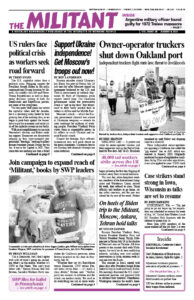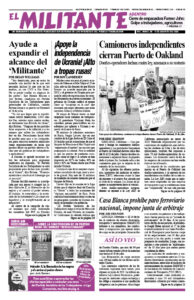A Miami jury found Argentine naval officer Roberto Guillermo Bravo liable July 1 for his role in what has become known as the Trelew Massacre, in a civil case brought by relatives of four of 19 political prisoners who were gunned down at a military base there in 1972.
The 50-year campaign that resulted in the trial helps expose the crimes of the monstrous U.S.-backed military dictatorships that ruled Argentina for much of the 1960s, ’70s and ’80s.
In 2012, three other officers who were with Bravo that day were found guilty of murder in an Argentine federal court and sentenced to life in prison. Argentine law prohibits trial in absentia and Bravo remained virtually untouchable in the U.S. But under the U.S. Torture Victims Protection Act, government agents responsible for torture or extrajudicial killings abroad can face civil penalties in the U.S.
The Miami jury awarded $24 million to family members of Eduardo Cappello, Rubén Bonet, and Ana María Villareal de Santucho who were murdered that day, and of Alberto Camps, who was gravely wounded.
Bravo testified that he shot at least 30 bullets from a machine gun and ordered the other officers to shoot, but claimed, despite overwhelming evidence to the contrary, that one of the prisoners had grabbed an officer’s gun and that Bravo only fired in self-defense.
The family members are using the verdict to strengthen their fight to have Bravo extradited to Argentina to stand trial for murder.
“My father survived the Trelew Massacre and wanted to dedicate his life to expose the truth of what happened, but he was murdered before he could see justice,” Raquel Camps said in a statement. She hoped the trial will “help us achieve his goal.”
“This case was never about the money,” Ajay Krishnan, the lawyer representing the families in the case, said in a press release. “It is about addressing a historic and heartbreaking injustice.”
The massacre took place during the military dictatorship of Alejandro Lanusse amid government repression aimed at derailing rising working-class struggles in the late 1960s and early ’70s that threatened capitalist rule in Argentina, part of a broader upsurge of workers and peasants in Central and South America.
Working-class upsurge in Argentina
The potential power of the working class was shown by the Cordobazo, when workers and students rose up on May 29, 1969, in Córdoba, Argentina’s third-largest city and center of the country’s auto and aerospace industries. Workers from auto plants, foundries, meatpacking and other factories went on strike and along with students headed to a rally in solidarity with protesters killed earlier in the week in the cities of Corrientes and Rosario.
Police fired on the protesters, killing Renault worker Máximo Mena. Entire working-class neighborhoods joined the revolt, building barricades, directing traffic, sharing food from common pots. An eyewitness report published in Intercontinental Press said, “By 3 p.m. 400 city blocks marked by bonfires and barricades had become a liberated zone in the hands of the population.”
When the government sent in troops, working people held off the army all night. By the end of May 31 the army had retaken the city at a cost of six dead, 50 wounded and hundreds arrested. But it was unable to impose stability for the capitalist rulers.
The 1969 Cordobazo marked the opening of a prerevolutionary situation in Argentina. Over several years, auto, oil, telephone, meatpacking and other workers waged hard-fought strike battles including factory occupations. Within industrial unions, class-struggle tendencies increasingly challenged the conservative trade union bureaucracy.
Debate over guerrilla warfare
Amid the growing ferment and the instability of bourgeois regimes, revolutionaries worldwide debated the course needed to lead working people to take power out of the hands of the capitalist class. Some, including the current in the world revolutionary movement that the Socialist Workers Party in the United States was part of, sought to build revolutionary parties rooted in the struggles of working people.
Others in Argentina and much of Latin America instead promoted guerrilla warfare by small groups as a strategy to take power. In 1970, the Peronist guerrilla group Montoneros kidnapped and assassinated former Argentine president Pedro Aramburu. Groups such as the Fuerzas Armadas Revolucionarias, and the People’s Revolutionary Army (ERP) carried out similar actions.
That ultraleft course left the working class on the sidelines and made it easier for the capitalist rulers to victimize revolutionary fighters and union militants. Thousands of courageous, revolutionary-minded militants were killed by the military.
The lessons of these class-struggle experiences can be found in The Leninist Strategy of Party Building: The Debate on Guerrilla Warfare in Latin America, by Joseph Hansen, a leader of the Socialist Workers Party.
In May 1972 the Argentine government began moving political prisoners to more remote locations to isolate them from supporters and unfolding struggles. A group of 25 prisoners who belonged to one or another of the guerrilla groups was sent to Rawson prison in Argentina’s Patagonia region. In mid-August they tried to escape. Six succeeded, including Mario Santucho, a central leader of the ERP, and flew to Chile and later to Cuba. Nineteen were recaptured and detained on the Almirante Zar Naval Base near the city of Trelew. They were repeatedly tortured and subjected to mock executions.
In the early morning of Aug. 22, 1972, four naval officers, including Bravo, ordered the prisoners to come out of their cells and line up in the hallway. Without warning the officers opened fire with machine guns and pistols. Some prisoners who survived retreated to their cells, where the officers methodically tracked them down. By the end of the day only three survived: María Antonia Berger, René Haidar and Camps.
Berger, in a letter she sent out from captivity, described how she “tried to play dead.” An officer came in to her cell and shot her already dead cellmate in the head, and then shot Berger. “The bullet went through my chin, smashed my right jawbone and lodged behind my right ear.”
Campaign to free political prisoners
The Socialist Workers Party in the United States and the Militant joined with others around the world in a campaign to save the lives of the Trelew survivors and other political prisoners. They held public meetings and circulated petitions signed by prominent individuals.
The three survivors were only freed in May 1973 when a civilian government replaced military rule. In the years after a new military coup in 1976, all three were assassinated by the regime.
From 1976 to 1983, in what became known as “the dirty war,” the military junta — with Washington’s complicity — killed or “disappeared” some 30,000 people. Some 500 children of those killed were also seized and given up for adoption, often to the families of military officials.
Meanwhile Bravo was living the good life in the U.S. Soon after the Trelew massacre he was sent to the U.S. as a military attaché to the Argentine embassy. He was given U.S. citizenship and set up his own health services business, making millions on U.S. government contracts.
The Argentine military dictatorship, facing increasing resistance, finally relinquished power in 1983. For decades, even under the military regime, the families of those killed and their supporters — from the Mothers of the Plaza de Mayo to the relatives of those killed in Trelew — courageously fought to find out the truth and expose the crimes of those responsible for the deaths of their loves ones. The recent trial is part of those hard-fought efforts.

